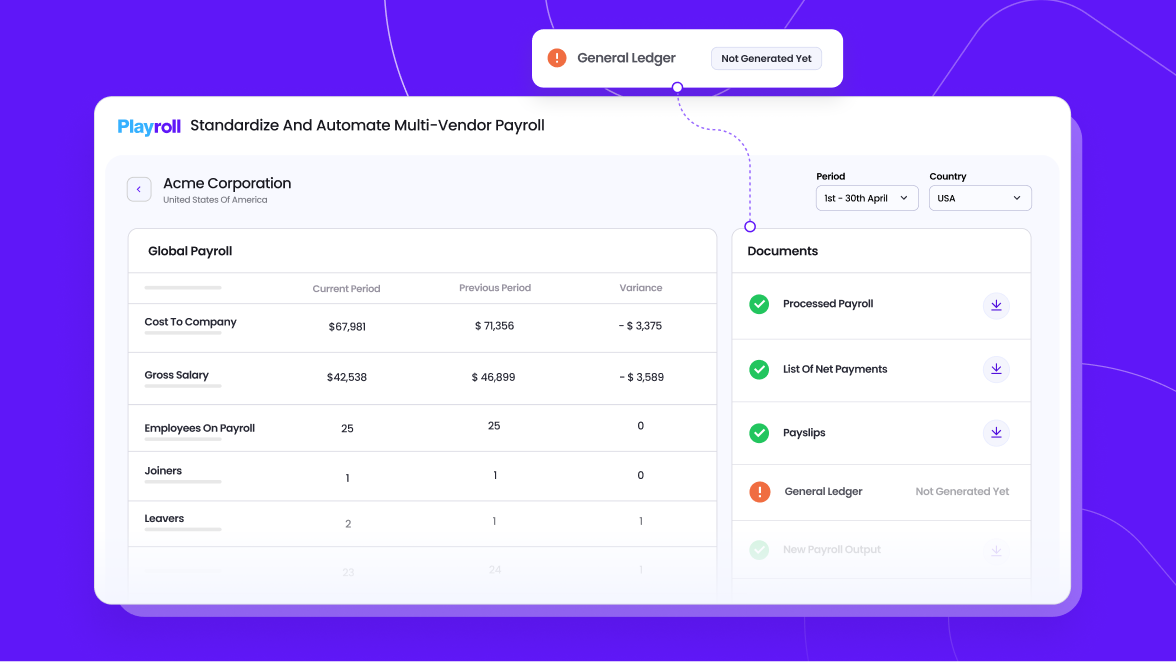Copied to Clipboard
Ready to get Started?


Key Takeaways
Classify workers correctly: Misclassifying an independent contractor when they’re really an employee can trigger tax issues and fines.
Build a solid payroll foundation: Collect the right forms, IDs, and choose whether manual methods, payroll software, or outsourcing (like EORs) fit your scale and needs.
Respect local labor laws: Every country has its own playbook. This means different minimum wage, overtime, and tax laws.
Make pay structure crystal clear: Break down gross pay, deductions (like Social Security, Medicare, and local taxes), and net pay. Clear pay structures help reduce confusion.
Maintain trust with thorough records: Consistent pay stubs, logs, and audits are more than compliance measures – they protect you against reputational damage.
Struggling with payroll or how to pay international employees compliantly? You’re not alone. The good news: recognizing the challenge is already a step in the right direction. In this guide, we’ll walk you through the essentials – calculating taxes, choosing compensation types, and avoiding common payroll pitfalls – so you can confidently pay employees across borders.
Employee satisfaction starts with people getting paid correctly and on time. You’re not just transferring money into a bank account; you’re delivering reassurance and building trust. For small businesses or teams dispersed globally, payroll can feel like a Herculean task: calculating gross pay, deducting taxes, obeying labor laws, and keeping records so thorough you're tempted to take a microscope to them. If that list feels overwhelming, don’t bail just yet. This guide breaks it down step-by-step, making paying employees simpler and more achievable.
Why Doing Compliant Payroll Right Is Important For Your Business
Think about what happens when payroll works perfectly: your team gets paid on time, your books are in order, and your business runs smoothly. Now, picture what happens if it goes off track. Regulations shift, mistakes happen, and suddenly you’re facing fines, reputational damage, and diminishing trust.
Here’s why ensuring compliant payroll matters:
- Avoid fines and penalties: The IRS finds payroll mistakes in 33 percent of businesses. That leads to costly amendments and sanctions.
- Prevent massive back-pay issues: Griffith University had to repay over A$8 million to 5,457 employees after long-running employee underpayments – proving how large errors harm reputation and cost millions
- Stop draining your time and budget: U.S. employers pay over $5 billion yearly in employment tax penalties.
- Protect sensitive data: Payroll systems store highly sensitive employee data. GDPR fines have exceeded €5.65 billion globally. A single breach can cost hundreds of millions.
- Build employee trust: More than half of workers worldwide have experienced payroll issues such as underpayment or delayed pay. These issues cause stress, anxiety, and undermine loyalty within a company.
A Step-By-Step Guide on How to Pay Employees Compliantly
Together, we’ll walk through how to make payroll work without confusion or risk. By the end of this guide, you’ll be equipped to handle classification, tax withholding, and payment with more clarity and less stress.
Step 1: Classify Workers Correctly
Getting worker classification wrong remains one of the costliest payroll mistakes most teams come to regret. Employers that mistakenly label employees as contractors risk substantial financial and legal repercussions. Classifying workers correctly is crucial as you change tax obligations, employee benefits, and legal protections by classifying someone as an employee versus an independent contractor. For example, employees typically qualify for Social Security, Medicare, unemployment insurance, and worker protections. Misclassifying them shifts tax liability and benefits (violating most local laws).
To avoid this misclassification, don’t just guess: Use tests for behavioral control, financial control, and the nature of the relationship to evaluate a worker’s status. In the U.S., the IRS uses these factors (also known as the ABC test) to determine classification. If you fail one factor, the worker is an employee, not a contractor. Correctly classifying your employees is no laughing matter, as misclassification leads to back taxes, penalties, and audits.
When you’re unsure of a worker’s classification, file IRS Form SS-8 for clarity and confirmation. Filing it early gives you official guidance, reduces risk, and keeps you proactive.
Step 2: Set Up Your Payroll System
Let’s start with breaking down the basics of how payroll is structured, which consists of three key elements: the gross pay, deductions and net pay. Familiarizing yourself with how this works is the first step to calculate gross pay, the true cost of your employees correctly, and avoid costly payroll errors.
Understand Payroll Structure
Break payroll into three parts:
- Gross pay: The total earnings an employee receives before any deductions. It includes salary, overtime, bonuses, and allowances. This figure sets the basis for payroll calculations.
- Net pay: The amount an employee actually takes home after all payroll deductions. This is the number deposited into their bank account.
- Deductions: Money removed from gross pay. They include mandatory items like taxes and social contributions, as well as voluntary items like insurance or retirement plan contributions.
For instance, if an employee earns $4,000 gross pay per month, and they have $800 deducted for taxes and benefits, their net pay would be $3,200.
Obtain EIN and Tax IDs
Your EIN acts as your company’s tax ID within the U.S. It’s free, often issued online, and required for hiring, filing taxes, and opening a business bank account. Foreign businesses without a U.S. address can still apply by phone or mail using IRS Form SS-4. You won’t build payroll without it.
Apart from the U.S., most countries require local tax identifiers, take Australia’s ABN or Germany’s Steuer-ID, before you can run payroll. This isn’t bureaucratic overreach; it’s business credibility.
Collect Employee Info (W-4, I-9 forms)
Secure every essential detail before payroll begins: full legal name, tax ID, pay frequency, and bank details for direct deposit. In the U.S., request a W-4 for tax withholding and an I-9 for eligibility. Your system must also adapt to different local requirements. Without accurate data, you’ll spend time fixing errors – a time-consuming and unnecessary process.
Choose Payroll Administration
Consider your options:
- In-house payroll: You keep full control over payroll and protect sensitive data on your premises. However, you take on all the responsibility of managing software, staying on top of changing laws, and must invest considerable time and resources.
- Payroll software: Automates calculations, tax updates, and reporting. It reduces errors and saves time. But you rely on the software and may face setup costs or support issues.
- Outsource or EOR: Saves time and cost by bringing experts on board to run payroll processing and handle compliance across borders. It gives you scale without having to build an internal team.
Decide on compensation types
Select and define your pay model clearly:
- Salaried: Works well for roles with fixed hours.
- Hourly: Requires careful tracking and overtime calculation.
- Commission or bonus formats: Reward results, but need precise rules.
Step 3: Ensure Compliance with Labor Laws
Every country sets its own payroll rules. These vary on minimum pay, overtime, benefits, withholdings, and reporting.
For instance, in the U.S., businesses must comply with the Fair Labor Standards Act (FLSA), which sets federal, state, and local minimum wage requirements and overtime rules. In contrast, European countries have their own tax codes and labor laws that must be followed.
- Understand local rules: Each country sets its own laws on wages, overtime, benefits, tax withholding, and payroll reporting. You lose trust and face penalties if you skip them.
- Track legal changes constantly: Labor laws shift often. Leverage free compliance resources, subscribe to relevant newsletters, or work with local lawyers or payroll experts to stay up-to-date.
- Build clarity across regions: Keep or use a central log of laws in every location. In this knowledge base, factor in national and sub-national rules. Also, leverage tools or systems that flag rule changes.
- Use local specialists or EORs where needed: They know the nuances. With an Employer of Record, you shift payroll, benefits, tax and compliance responsibilities to the experts.
- Prepare for audits: Government compliance checks happen. Keep payslips, tax files, and benefit records for required retention periods.
Step 4: Determine the Type of Compensation You Offer Employees
When structuring employee compensation, businesses must decide whether to pay employees a fixed salary or an hourly wage. Salaried employees receive a consistent paycheck and a more consistent work contract, while hourly employees are paid based on the number of hours worked and includes overtime calculations.
Beyond base pay, companies may also offer bonuses, commissions, or profit-sharing to reward performance to boost employee retention.
You decide how pay motivates performance and fits your setup. Let’s break down the options and when each works best:
Salary vs Hourly
With salaried employees, you pay a fixed amount at regular intervals (monthly, biweekly, or weekly). Salaried employees are guaranteed a steady paycheck regardless of hours worked. Employers are often expected to offer benefits such as healthcare, retirement plans, and paid time off. This builds stability around their role and schedule. These workers are generally exempt from overtime. This simplifies payroll but may lead to unpaid extra work.
Use this for roles with stable responsibilities or professional work.
On the other hand, hourly employees’ pay is based on actual time worked. These employees are eligible to receive overtime pay but typically only for hours over defined thresholds, like 40 per week in the U.S.. The hourly compensation structure offers employers flexibility and the ability to control costs for fluctuating workloads as payroll adjusts to actual hours worked. Under this compensation structure, the onus is on employers to track hours worked accurately, as mistakes can trigger errors in overtime and compliance. Use this structure where workforce demand shifts (retail, service and seasonal roles).
Step 5: Calculate Employee Pay and Tax Deductions
You’ll only get payroll right if your math adds up from gross pay down to what lands in your team’s account. Let’s break that process into three key steps: calculate total pay, apply legal deductions, and include your employer costs.
- Start with Gross Pay: Include base pay, overtime, bonuses, or paid time off. You need a solid number before you deduct anything.
- Subtract Required Deductions and Add Any Voluntary Deductions: These often include payroll taxes, social security contributions, and retirement or benefit plan contributions. Rules change by country, so always check local law. Voluntary deductions include contributions to healthcare, retirement savings, or court-ordered garnishments. But first, make sure you’re authorized to withhold these amounts.
- Account for Employer Contributions: Payroll calculations don’t end with what the employee earns. You also pay taxes and contributions, like unemployment or social insurance, depending on the country and jurisdiction.
Step 6: Choose the Right Payment Methods
Now that you’ve decided on the compensation structure, it’s time to decide how you pay your team. It’s best to opt for a method that fits your people and set up the best. There are a few payment methods to choose from:
- Direct deposit: This is the default for a reason. It’s quick, secure, and puts money straight in your employees’ bank accounts. Many global platforms let you pay across borders from one dashboard. This allows for centralized, currency-smart payments without the need for multiple local bank accounts.
- Payroll cards: These are like prepaid debit cards. They’re a good fit for teammates without access to banks. But watch out – fees for ATM withdrawals or reloads can add up fast.
- Digital Wallets: E-wallets are great for speed and funds typically reach teammates instantly. You can even fund wallets in different currencies. This option is ideal when you want fast, flexible payouts. Not every country accepts them yet, so check local popularity and access.
Managing payroll across borders comes with a plethora of challenges, such as multiple currencies, varying regulations, and different vendors.
That’s where a global payroll management solution steps in. Playroll’s global payroll solution pulls together multi-entity and multi-vendor payroll data into a single dashboard. You keep your existing providers, map data in minutes, automate payments and variance controls, and keep everything audit-ready. The platform gives you real-time visibility into payroll activity, reports, and risks – all in one place.
Step 7: Set Up a Payroll Schedule
The right payroll schedule depends on your industry and your team’s preferences – and it can make all the difference in how smooth payroll feels. Let’s break down the most common schedules and how to pick one that fits your global operations:
- Weekly: This means running payroll every week, which works well for hourly or frontline workers. It takes more work, but it fits cash payments-first operations.
- Biweekly: You pay every two weeks (26 times a year). This is the most common pay rhythm in the U.S., with 43 percent of companies using it.
- Semi-monthly: You pay twice a month (24 times annually), usually around the 1st and the 15th. It aligns nicely with monthly reporting.
- Monthly: You pay once a month. This is the least common choice (only about 4 percent of companies use it). This pay schedule is easy on admin, but harder for cash flow and harder for hourly workers.
How To Pick The Right Pay Schedule
Think about your cash flow, your industry, employees’ preferences and how your team prefers to get paid. If your staff includes retail or hourly staff, weekly or biweekly makes sense.
For a salaried, office-based team, semi-monthly or monthly may work better. Be sure to keep compliance top of mind because some countries require minimum frequencies.
Step 8: Recordkeeping and Reporting
To tie it all up, you have to keep accurate payroll records (especially when operating across multiple countries). It’ll protect your business and make audits smooth in the long run.
Start by storing all key documents. These include pay stubs, timesheets, contracts, benefits deductions, tax filings, and objective payroll calculations. The U.S. Department of Labor (DOL) requires you to keep basic payroll records for at least three years and data used for wage calculations for at least two years. The IRS strongly recommends holding onto employment tax records, W-2s, and related documents for at least four years.
Going beyond U.S. law, remember that global rules vary: some places require payroll data to be kept for up to six or even seven years. In the EU and parts of APAC, you must balance legal retention with privacy regulations, such as GDPR.
Instead of paper files and scattered folders, opt for a digital system or payroll platform. It helps you store and search records faster, protects against loss, and simplifies audits or employee questions.
What is the Best Way to Pay Employees: Manual Payroll vs. Payroll Software?
Now that we’ve covered how to pay your employees compliantly, let’s compare two methods for paying your team. One keeps things low-tech and hands-on. The other prioritizes speed, accuracy, and scale:
When Manual Payroll Makes Sense
Manual payroll works best when your team is small and your payroll rules stay simple. You control every step, from tracking hours to handing out checks. It costs you only time, not software. It generally makes sense if you don’t have much payroll to wade through.
When a Payroll Software Makes Sense
As your team grows or your payroll complexity increases, imagine multiple vendors or varying local rules, and software becomes essential. Payroll software automates calculations, tax deductions, compliance updates, and reporting. Multi-vendor payroll tools like Playroll bring local payroll providers into one secure dashboard, transform any data source in minutes, and support bi-directional data flows. You can keep your preferred vendors or swap them anytime. This simplifies your global payroll management and keeps you compliant.
Common Mistakes When Paying Employees and How to Avoid Them
Payroll errors can snowball beyond an annoyance to a serious company-wide issue. If not handled properly, payroll errors can be costly, diminish employee trust, and erode your reputation over time. Let’s look at the biggest payroll mistakes companies make and how to avoid them:
- Misclassifying Workers: It’s easy to treat someone as a contractor when they actually function like an employee. But that mistake triggers back taxes, fines, and legal risk (especially in countries with strict labor laws). Fix it by defining roles clearly, using formal contracts, and checking local tests (like the “ABC Test”) or forms like the IRS Form SS‑8.
- Falling Behind on Regulatory Changes: Labor and tax laws change all the time (and often without warning). Missing a minimum wage increase or tax update creates fees and rework. Avoid this by subscribing to local compliance alerts or partnering with in-country payroll experts who track changes for you.
- Skipping Payroll Audits: Assuming your payroll is in perfect condition is a mistake many come to regret. Even small errors, like logic mistakes in overtime or benefit deductions, accumulate fast when you’re running payroll in multiple countries. Schedule regular audits, use checklists, and watch out for misclassification or incorrect tax withholding.
- Using Manual or Disconnected Systems: Manual or spreadsheet-based payroll in a global setup is a recipe for errors. Data gets out of sync, legal updates go unnoticed, and records become messy. The solution? Automate with tools that link payroll, HR, and vendor systems to keep everything accurate and scalable.
- Inconsistent or Late Payments: Changing pay dates or issuing late paychecks damages trust and leads to frustration (and sometimes even legal trouble). Set a clear, standard schedule (weekly, bi-weekly, or monthly) and keep it consistent across all locations to avoid confusion.
Regular payroll audits are an essential process that helps you spot mistakes early, before they snowball into real problems. When you automate audits through tools like Playroll, you get real-time visibility across your entire global payroll, enabling you to catch inconsistencies before they cost you.

Running payroll for global employees goes far beyond merely cutting checks. To stay on top, you need to juggle tax rules, local labor laws, payment structures, and compliance – all at once. Automating payroll not only reduces errors but also gives you back time.
If you manage payroll across borders, Playroll gives you a single dashboard that consolidates payroll data from every country you operate in. You keep working with your existing vendors, but now everything’s clean, compliant, and instantly visible. It’s confidence in your payroll all without reinventing your systems.
How To Pay Employees FAQs
How do you pay offshore employees?

.png)
Use a global payroll platform that handles multi-country compliance, currencies, and vendors in one place. For example, Playroll’s multi-country payroll solution centralizes everything into a single dashboard, while perfecting compliance across all your operating regions.
What is the best way to pay employees?

.png)
The best method combines reliability and compliance. Direct deposit offers speed and accuracy. For global teams, payroll software that automates country-specific tax rules and local laws is the smart choice (especially when legal risk and time are at stake).
How often should you pay employees?

.png)
Pick what aligns with your operations, employees’ preferences, and local rules.
What types of payment can an employer use to pay employees?

.png)
Employers worldwide use several methods: Direct deposit/bank transfer, paper checks, prepaid payroll cards, and e-wallets or digital wallets (where supported).
.svg)
.svg)
.svg)

.svg)
.svg)





.png)

.png)

.png)

.svg)















.svg)